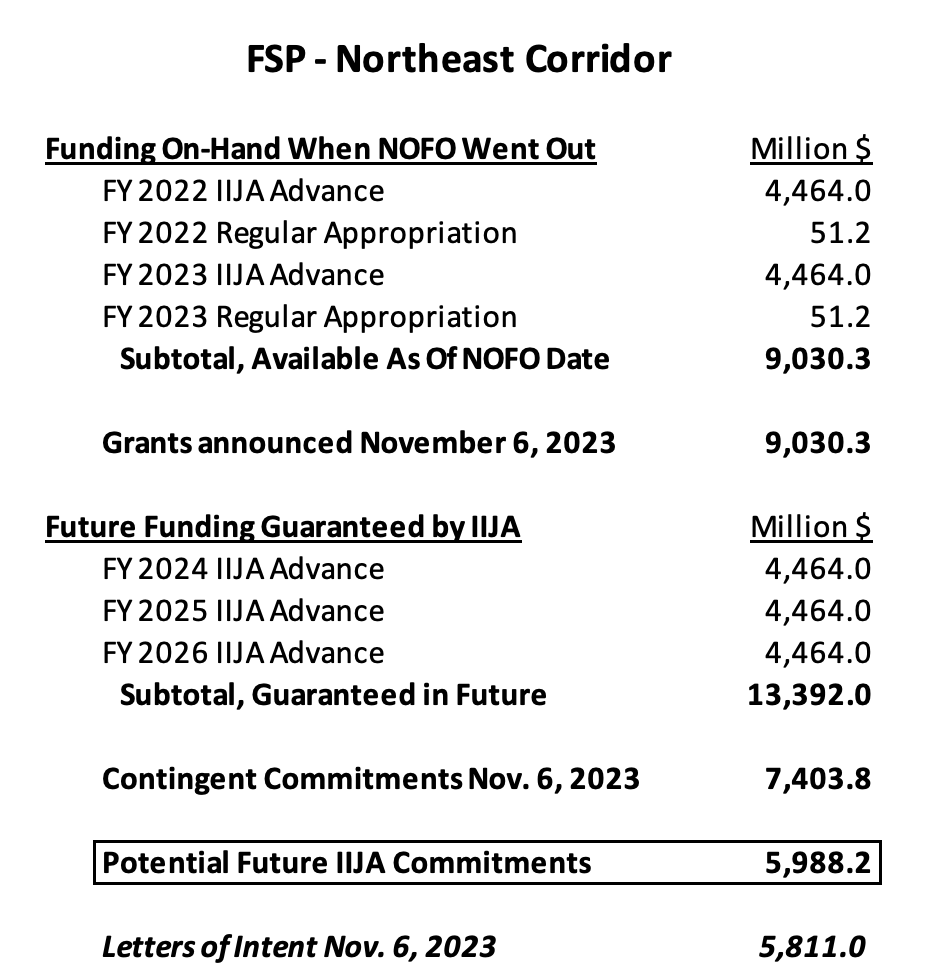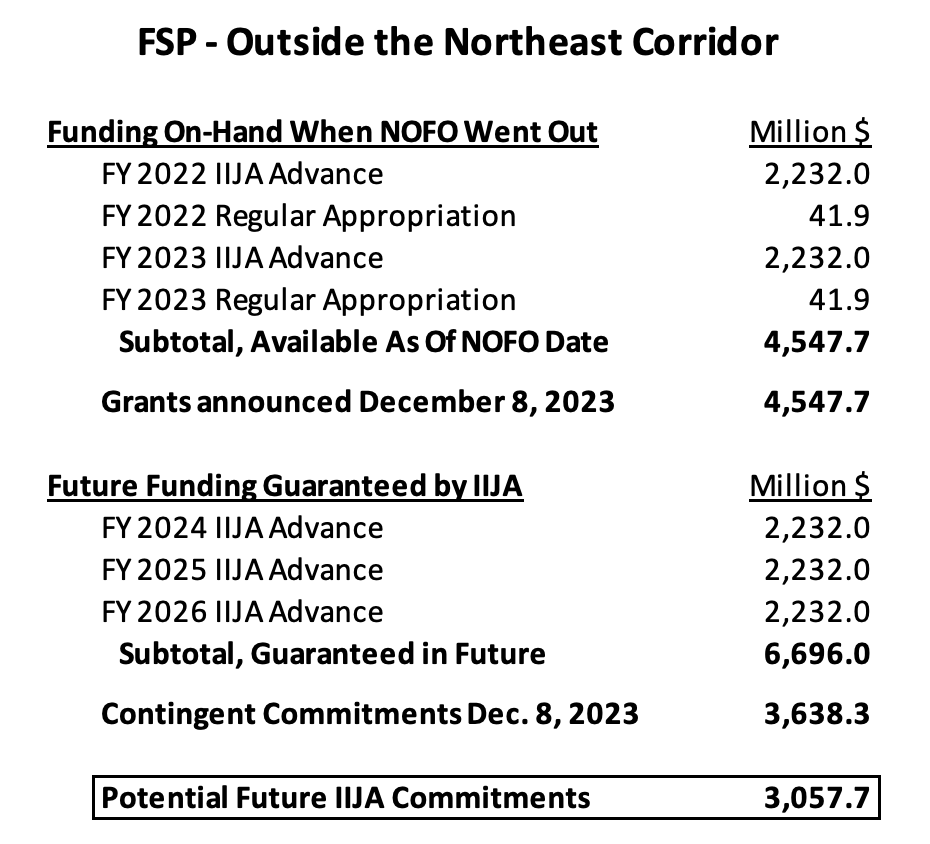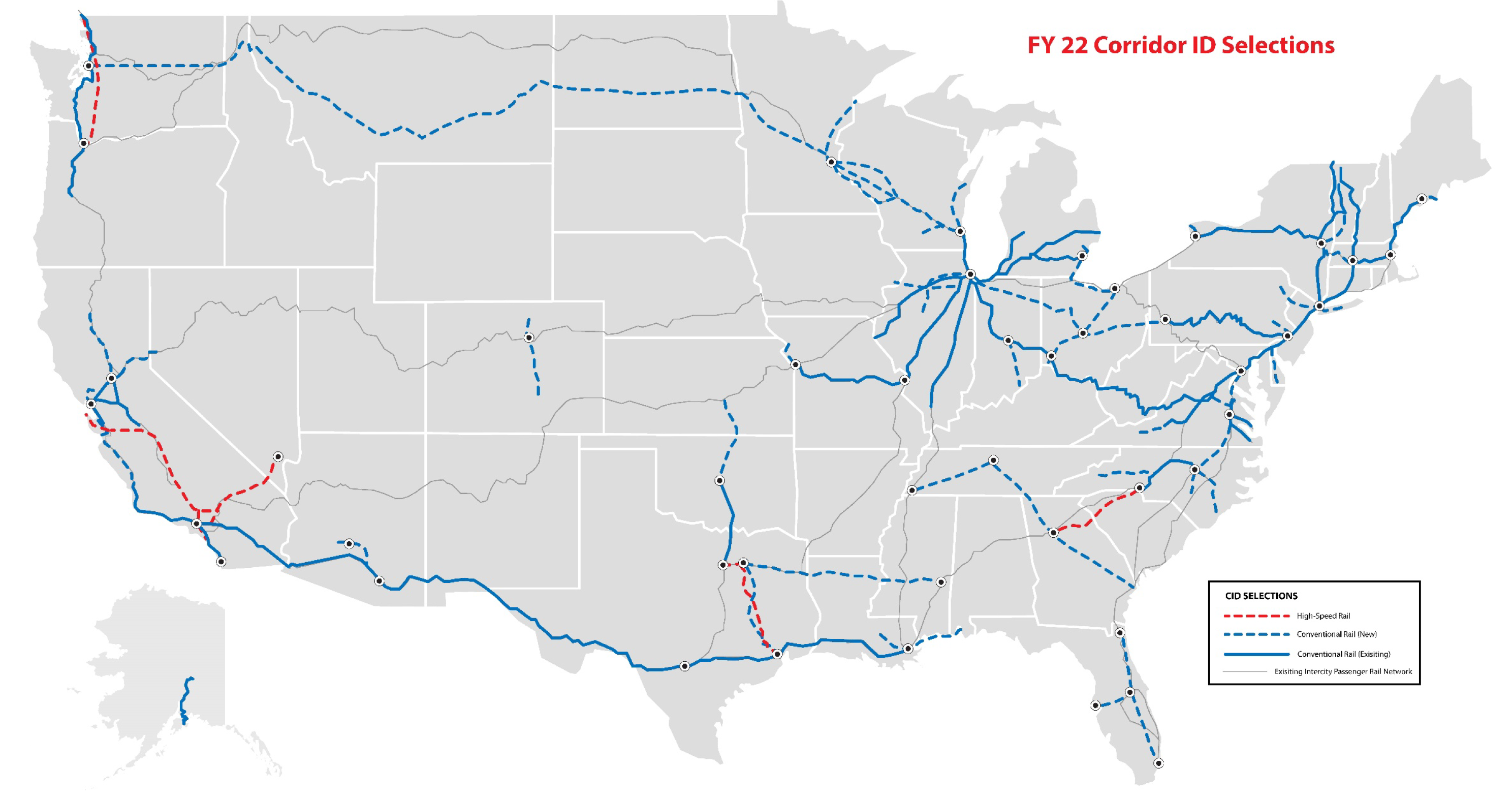Today, the Biden Administration is announcing $8.2 billion in grants for ten projects providing enhanced and new passenger rail service in the coming years outside the Northeast Corridor as part of its implementation of the bipartisan infrastructure law.
(The full FRA fact sheets for each of the ten projects can be read here.)
President Biden is traveling to Las Vegas today to announce the funding because the second-largest grant being announced today is $3.0 billion for the Brightline West high-speed rail project, which hopes to build true high-speed rail along a 218-mile line from Las Vegas, NV to Rancho Cucamonga, CA, at speeds of up to 186 miles per hour. (Faster than even Raoul Duke and Dr. Gonzo could drive their car along the same route.)
The program is the “Federal-State Partnership for Intercity Passenger Rail” grant program, a high-profile part of the Infrastructure Investment and Jobs Act (IIJA).
By USDOT grant program standards, four of the ten grants being announced today are enormous, with the rest being in the range that other programs have provided in the past.
The biggest grant is $3.1 billion to the California High Speed Rail Authority to help fulfill Governor Gavin Newsom’s interim vision of an operational high-speed line between Merced and Bakersfield. The money will go towards part of the cost of extending the Initial Construction Segment (the part funded by the Obama Administration 13 years ago) northward from Madera (pop. 66,224) to Merced (pop. 86,333) and southward from Shafter (pop. 16,988) into Bakersfield proper (pop. 403,455), and electrifying track and buying actual trainsets. (As a separate article in this issue notes, this $3.1 billion still leaves CHSRA several billion dollars short of being able to finish the Merced-Bakersfield section, much less go anywhere near San Francisco or Los Angeles.)
After the aforementioned $3.0 billion Brightline project, the next-largest grant is $1.1 billion for an early part of a much more expensive attempt to bring passenger rail service from Raleigh, NC to Richmond, VA. This grant is just to upgrade existing CSX track between Raleigh and Wake Forest. The real problem, as the map provided by sponsors shows, is on the Virginia side of the state line, where there is no existing, operational track.

The fourth large grant, $729 million, goes to improve passenger rail immediately to south of the nation’s capital down to Richmond, VA. The centerpiece is the replacement of the Long Bridge across the Potomac (parallel and adjacent to the 14th Street Bridge/I-395 complex), but it also includes improvements at L’Enfant Plaza’s VRE station and extra sidings near Woodbridge, Brooke, and Spotsylvania, VA.
| CA |
California High-Speed Rail (Merced-Bakersfield) |
$3,073,600,000 |
| NV-CA |
Brightline West (Las Vegas – Rancho Cucamonga) |
$3,000,000,000 |
| NC |
Raleigh-to-Richmond (Raleigh – Wake Forest) |
$1,095,576,000 |
| DC-VA |
DC-Richmond Phase 2 |
$729,000,000 |
| PA |
Keystone West (Pittsburgh-Harrisburg) |
$143,629,028 |
| IL |
Chicago Union Station Mail Platform Reactivation |
$49,600,000 |
| IL |
Chicago Union Station Platform Capacity Expansion |
$44,000,000 |
| ME-NH |
Downeaster Corridor (New Brunswick-MA State Line) |
$27,492,000 |
| MT |
Empire Builder improvements in Malta, MT |
$14,900,000 |
| AK |
Alaska Railroad Milepost 190.5 Bridge Replacement |
$8,200,558 |
|
TOTAL |
$8,185,997,586 |
All grants are for 80 percent of a project’s costs, except possibly for the Virginia DC-Richmond project, where the grant notification was phrased confusingly.
Because the Notice of Funding Opportunity (NOFO) for this program was published in December 2022, when only the first two years of IIJA-guaranteed funding were available, the three largest grants announced today use “contingent commitment authority” – part of the grant money being announced today comes from the fiscal 2023 and 2024 appropriations, but money is also pledged from the 2024 IIJA appropriation (which was not yet available when the NOFO was released but is now) and the 2025 and 2026 IIJA appropriations (which will not become available until October 1, 2024 and October 1, 2025, respectively).
Where the money came from and how much remains
The IIJA provided an astounding $36 billion for the Federal -State Partnership for Intercity Passenger Rail program over five years, divided into five equal annual tranches of $7.2 billion each, with the restriction that no more than two-thirds of the funding go towards projects on the Northeast Corridor.
This being the Biden Administration, and the NEC being where most rail passengers are, the Administration decided to give the NEC the entire two-thirds of the program, so that’s $24 billion on the NEC and $12 billion off.
After oversight and corridor development set-asides, $4.464 billion per year was available for NEC projects and $2.232 billion per year for off-NEC projects.
|
$7,200m per Year (x5 years) |
|
2/3 on NEC |
1/3 off NEC |
| Per Year: |
4,800 |
2,400 |
| Minus 5% for Corridor Development |
-240 |
-120 |
| Minus 2% for Oversight |
-96 |
-48 |
| Remainder for FSP Grants |
4,464 |
2,232 |
Congress also appropriated $100 million in each of fiscal 2022 and 2023, which the Administration could split between NEC and off-NEC up to 55%-45% (after the 7% in set-asides).
Here’s how the NEC funding, announced November 6, was split between on-hand and future IIJA funding:

For the NEC, the Administration announced $16,434 billion in grants, $9.0 billion from money already in-hand at the time the NOFO was published and $7.4 billion in contingent commitments of guaranteed funding from the last three years of the IIJA, which left $6.0 billion in future IIJA funding to go on the NEC.
But the November 6 announcement also pledged $5.8 billion in “letters of intent” for future projects, which, depending on how you read subsection (g) of 49 U.S.C. §24911, could either be pledge against the remaining $6 billion of IIJA money or other appropriations to be made by Congerss. If it’s the former, then there is only $177 million left for more NEC projects out of the IIJA funding.
Now, here’s how today’s announcement of funding is split between on-hand and future IIJA funding:

No letters of intent were mentioned in today’s announcement, so $3.06 billion in guaranteed IIJA advance appropriations is available for future off-NEC capital projects. And there may be more competition for that money because of a separate set of announcements made today.
Future corridor designations
Out of that $36 billion advance appropriation in the IIJA for the FSP program, five percent $360 million) is set aside for corridor development activities under 49 U.S.C. §25101. This required local entitles to apply for intercity passenger rail corridor designation pursuant to this December 2020 NOFO, and successful applicants would then get several advantages:
- Official designation as a corridor, accompanied with a $500,000 grant (at a 100 percent federal share), to be used to develop a scope, schedule, and cost estimate for a full “service development plan” (SDP) for that corridor;
- Eligibility for a future “Step 2” grant out of the $360 million pot for preparation of the Service Development Plan;
- Eligibility for a future “Step 3” grant out of the $360 million pot for project development activities for projects on the SDP, including preliminary engineering and NEPA paperwork; and
- Priority in selection for the remaining $3.06 billion in off-NEC appropriations, and any future appropriations, for the FSP program, pursuant to subsection (d)(2)(A)(ii) of 49 U.S.C. §24911.
As part of today’s rollout, USDOT is announcing $500,000 corridor development Step 1 grants to 69 corridors, totaling $34.5 million. Only six are for high-speed rail and the remainder are for conventional service, either new or existing, as shown on this map:

As both the map above and the list below show, some of these corridors are only going to get significant federal investment in some alternate universe where modern monetary theory doesn’t spark inflation, but if the real point of the exercise is to spread excitement and anticipation about federal rail investment as far and wide as possible, so as to maximize the number of people begging Congress for more FRA appropriations every year, this is the kind of list you would come up with.
(On the other hand, by declaring this many corridors and spreading expectations of future funding so widely, this makes it more difficult to give the California HSR project 38 percent of total off-NEC funding in future grant cycles, as happened in this one.)
| AK: Alaska |
Anchorage North and South Corridor |
| AZ: Arizona |
Phoenix – Tucson Corridor |
| CA: California |
High Desert Intercity High-Speed Rail Corridor |
| CA: California |
San Joaquin Valley Corridor |
| CA: California |
Los Angeles – San Diego – San Luis Obispo (LOSSAN) Rail Corridor |
| CA: California |
Coachella Valley Rail Corridor |
| CA: California |
Central Coast Corridor |
| CA: California, NV: Nevada |
Capitol Corridor |
| CA: California |
California High-Speed Rail Phase 1 Corridor |
| CO: Colorado |
Colorado Front Range Corridor |
| CT: Connecticut |
Hartford Line Corridor |
| DC: District of Columbia; NY: New York; NJ: New Jersey; PA: Pennsylvania; DE: Delaware; MD: Maryland; VA: Virginia; WV: West Virginia; KY: Kentucky; OH: Ohio; IN: Indiana; IL: Illinois |
Daily Cardinal Service |
| DE: Delaware, MD: Maryland |
Diamond State Line |
| FL: Florida |
Miami-Orlando-Tampa Corridor |
| FL: Florida |
Jacksonville-Orlando-Miami Corridor |
| GA: Georgia |
Atlanta to Savannah Corridor |
| IL: Illinois |
Peoria to Chicago Passenger Rail Service |
| IL: Illinois |
Chicago to Quad Cities Service Extension Program |
| IL: Illinois |
Chicago to Carbondale Corridor |
| IL: Illinois, MO: Missouri |
Chicago to St. Louis Corridor |
| IN: Indiana |
Chicago, Fort Wayne, Columbus, and Pittsburgh |
| IN: Indiana, IL: Illinois |
Indianapolis – Chicago Corridor |
| KS: Kansas, OK: Oklahoma |
Heartland Flyer Extension |
| KY: Kentucky, IN Indiana |
Louisville-Indianapolis Passenger Rail Corridor |
| LA: Louisiana |
Baton Rouge – New Orleans Corridor |
| LA: Louisiana, TX: Texas, NM: New Mexico, AZ: Arizona, CA: California |
Daily Sunset Limited Service |
| MA: Massachusetts, NY: New York |
Boston and Albany Corridor |
| ME: Maine, NH: New Hampshire, MA: Massachusetts |
Downeaster Corridor |
| MI: Michigan; IN: Indiana, IL: Illinois |
Wolverine Corridor |
| MI: Michigan, IN: Indiana, IL: Illinois |
Chicago to Grand Rapids Corridor |
| MI: Michigan, IN: Indiana, IL: Illinois |
Chicago to Port Huron Corridor |
| MN: Minnesota |
Northern Lights Express |
| MO: Missouri |
Kansas City, MO to St Joseph, MO |
| MO: Missouri, IL: Illinois |
Hannibal Extension of Existing Chicago-Quincy Corridor |
| MS: Mississippi, LA: Louisiana, AL: Alabama |
Gulf Coast Passenger Rail Service |
| MT: Montana; IL, Illinois, WI: Wisconsin, MN: Minnesota, ND: North Dakota, ID: Idaho, WA: Washington |
North Coast Hiawatha |
| NC: North Carolina |
Wilmington to Raleigh, North Carolina Corridor |
| NC: North Carolina |
Fayetteville to Raleigh, North Carolina Corridor |
| NC: North Carolina |
Charlotte to Kings Mountain, North Carolina Corridor |
| NC: North Carolina |
Asheville to Salisbury, North Carolina Corridor |
| NC: North Carolina |
Winston-Salem to Raleigh, North Carolina Corridor |
| NC: North Carolina, SC: South Carolina, GA: Georgia |
Charlotte, North Carolina to Atlanta, Georgia Corridor |
| NC: North Carolina, VA: Virginia |
Charlotte, North Carolina to Washington, DC Corridor |
| NV: Nevada, CA: California |
Brightline West High-Speed Corridor |
| NY: New York |
Amtrak to Long Island |
| NY: New York |
Empire Corridor |
| NY: New York |
Adirondack Corridor |
| OH: Ohio |
Cleveland-Columbus-Dayton-Cincinnati (3C&D) Corridor |
| OH: Ohio, MI: Michigan |
Cleveland-Toledo-Detroit Corridor |
| PA: Pennsylvania |
Keystone Corridor: Pittsburgh to Philadelphia |
| PA: Pennsylvania |
Reading – Philadelphia – New York Corridor |
| PA: Pennsylvania, NJ: New Jersey, NY: New York |
Scranton to New York Penn Station Corridor |
| TN: Tennessee, GA: Georgia |
Atlanta-Chattanooga-Nashville-Memphis Corridor |
| TX: Texas |
Amtrak Texas High-Speed Rail Corridor |
| TX: Texas |
Fort Worth-to-Houston High Speed Rail Corridor |
| TX: Texas |
Texas Triangle: Dallas-Fort Worth – Houston Intercity Passenger Rail Corridor |
| TX: Texas |
Houston to San Antonio Corridor |
| TX: Texas, LA: Louisiana, MS: Mississippi |
I-20 Corridor Intercity Passenger Rail Service |
| VA: Virginia |
Washington, DC to Bristol, VA Corridor |
| VA: Virginia |
Commonwealth Corridor |
| VT: Vermont |
Vermonter Corridor |
| VT: Vermont, NY: New York |
Green Mountain Corridor |
| WA: Washington, OR: Oregon |
Cascadia High-Speed Ground Transportation Corridor |
| WA: Washington, OR: Oregon |
Amtrak Cascades Corridor |
| WI: Wisconsin |
TCMC Service Expansion via La Crosse |
| WI: Wisconsin |
Milwaukee to Green Bay (Hiawatha Service Extension) |
| WI: Wisconsin, IL: Chicago |
Milwaukee to Chicago Hiawatha Service Expansion |
| WI: Wisconsin; MN: Minnesota |
Milwaukee – Madison – Eau Claire – Twin Cities Passenger Rail Extension |
| WI: Wisconsin, MN: Minnesota |
Eau Claire-Twin Cities Corridor |







